It was the kind of day that shouldn’t have happened. Somebody dropped the ball at CNBC, or something.
Thursday evening, after three morose days in US stock markets, Amazon came out and said it made a profit! OK, a teeny-weeny profit of $92 million, a barely perceptible 0.4% of sales, a rounding error for other thriving companies’ with $23 billion at the top line. But for Amazon, the mere fact that there wasn’t a minus-sign in front of it, for once, was huge.
Its shares soared 22% after hours. The company’s valuation jumped by $40 billion. CNBC exploded with excitement. And Friday should have been a huge day for stocks.
But oh my!
From the first minute on, Amazon’s shares lost steam, drifted lower throughout the day and gave up half of their afterhours gain. The S&P 500 and the NASDAQ lost over 1%, the Dow almost 1%.
It topped off a bad week:
- The Dow dropped 2.8%, its worst week since December 2014, broke its 200-day moving average, and is in the red for the year.
- The Dow Transportation index fell 2.8%, its worst week since March, and hit a 9-month low, down 12% for the year.
- The S&P 500 dropped 2.1%, its third worst week in 2015, and is up a mere 1% for the year.
- The Nasdaq dropped 2.2%, its worst week since March.
- The Russell 2000 swooned 3.1%, its worst week since October 2014
It didn’t help that Biotechs collapsed.
Biogen set the tone. It slashed its sales growth forecast for 2015 in half. Its multiple sclerosis drugs, its mainstay, are in trouble. Sales of Tecfidera, its main growth driver since its launch in 2013, ran smack-dab into reports linking it to brain infections. Sales of its injectable MS drug Tysabri and interferon-based MS drug Avonex both fell more than expected. And sales of Plegridy also disappointed. Shares of Biogen plunged 22%, wiping out $25 billion in stockholder wealth.
The Biotech ETF (XBI) dropped 3.6%. XOMA, which had already been eviscerated on Wednesday, dropped another 9.6% on Friday, to 94 cents, down about 80% for the week. A total of 25 biotechs in the index plunged over 5% on Friday.
Crude oil got hammered all week.
Particularly on Friday when WTI dropped to $47.97 a barrel, just weeks after $60 a barrel had been considered the new low going forward. Energy companies got slammed. Many of them are junk-rated, and their bonds sold off this week, dragging down the world’s largest junk-bond ETF (HYG) by 1.4%.
And just to show how fragile the newly bred IPOs are: Our California darling TrueCar, which went public last summer, lowered its outlook on Thursday afterhours and plunged 36% on Friday to $6.87 a share, down 24% from its IPO price of $9, and down 73% from its IPO-hype peak last year.
Here’s the misbegotten week for the S&P 500 index (chart by Doug Short at Advisor Perspectives):
So how badly did the S&P 500 get whacked?
In the overall scheme of things? Not much! This weekly chart by Doug Short shows that the index has dropped below its 10-week moving average (blue line), once again, but remains resolutely in the same very narrow range of the past five months:
And here’s a long-term chart that shows the rallies and sell-offs since 2007. Turns out, this “sell-off,” if you can call it that, isn’t much of a sell-off, nor has there been a real sell-off since 2011. It makes the current languid stability of the S&P 500 near its all-time high for five months a nail-biter kind of a proposition:
And in the rest of the world?
Doug writes in his World Markets Weekend Update:
Seven of the eight indexes on our world watch list gave back part of their gains from the previous week. The one positive outlier was the manic-depressive Shanghai Composite, which advanced 2.87% over the past five sessions.
The government-mandated 12-session rally of the Shanghai Composite leaves it down “only” 21% from its crazy-bubble peak, after having crashed 32% by July 8.
The Western indexes fared the worst of our gang of eight. The UK’s FTSE 100 was the worst loser and a negative outlier in that its -2.88% decline more than eradicated its gain from the previous week.
This chart with an overlay of the eight indices so far in 2015 highlights Shanghai’s nicely defined bubble (top blue line):
This table by Doug Short summarizes the performance of these indices so far in 2015, sorted from high to low.
Note the column, “2015 Peak.” It shows the indices’ gains at their respective peaks this year. I want to direct your attention to number 2 on that list, the French CAC 40, up 18% year-to-date.
The irony is that the French don’t have much of an appetite for stocks. Their economy isn’t exactly booming either. This is foreign buying, mostly US hot money that has been pouring into the Eurozone to ride up Mario Draghi’s QE escalator.
Germany’s DAXK (price only, whereas the DAX includes dividends) went through the same procedure last year and early this year, front-running QE. In 2015, by April 10, in 100 calendar days, it had booked a gain of over 25%, only to give up half of it in the jagged swoon since.
The languid, range-bound stock market in the US over the past five months is treacherous; it’s not going to remain languid forever. It could break to the upside, for example if a Fed official spouts off some kind of craziness on CNBC or Bloomberg TV. Or it could break to the downside. Then, hopefully, all those sitting with their cursor hovering over the sell-button won’t click it all at once.
But even if the market were a “life-time short” opportunity, I’d never short it. I’d leave that to braver souls. Read…. Why I Don’t Short Stocks or Bonds in this Crazy Environment Where Nearly All Assets Are Overpriced
Enjoy reading WOLF STREET and want to support it? You can donate. I appreciate it immensely. Click on the beer and iced-tea mug to find out how:
Would you like to be notified via email when WOLF STREET publishes a new article? Sign up here.
![]()

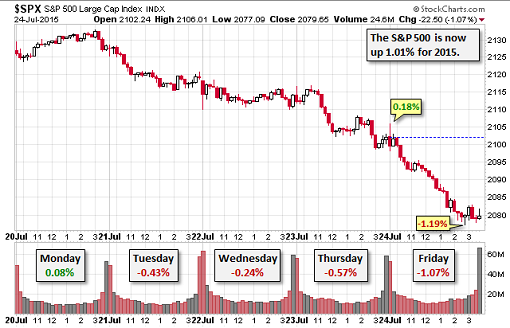
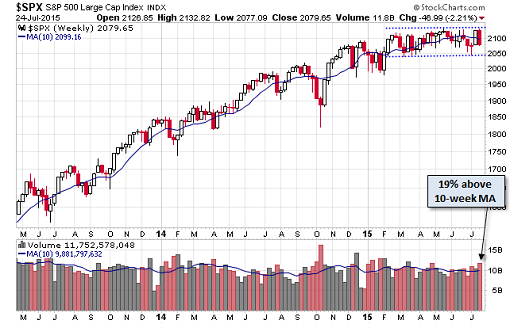
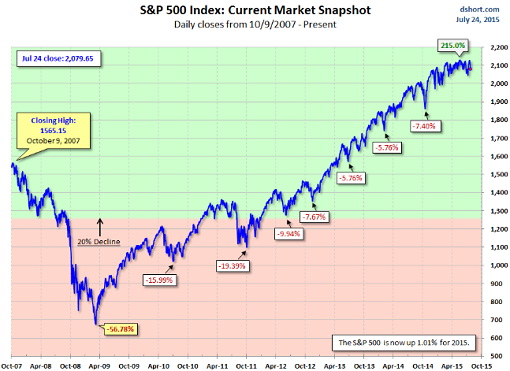
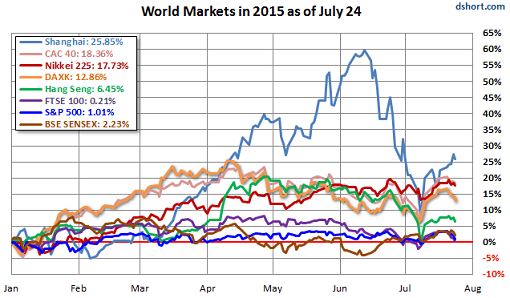
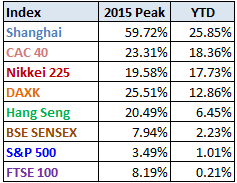

The Japanese are protesting in the streets asking the PM to resign, you know its bad now.
Mainly due to Abe’s war posturing …
Which is a weather vane of his out-of-touchness. As a member of the old-money elite families, Abe positively despises the common masses and berates them in private for not doing what he wants. It’s probably been 30 years since he’s ever rubbed shoulders with the common man on the street.
Nice wrap-up of the realities Wolf.
I think the market will meander along thru lazy days of summer and excrements hit the fan all over the world in Sept and Oct like say 2008, 1998 LTCM debacle and lest we forget 1986.
Commodity price collapse also portend weak global demand and economy, junk bond weakness, tumultuous currency (USD strength while devaluations elsewhere) and futile and amateur Chinese market (commies buying up the market and prevent selling, etc).
The trouble with a “life-time short”, Wolf, is that you don’t know it until much later, after the “casino odds” have run their course.
And as you have said many times, we are playing in a casino (run by biased croupiers, I might add).
Lions and tigers and BEARS oh, my!
“Crude oil got hammered all week”
and yet gas here in southern California is over $4 a gallon and nobody seems to care.
$3.99 down the street from us (in SF) for regular. But remember, there’s no oil pipeline across the Rockies. The West Coast lives off its own production and imports, and its own refineries. So if there’s a problem with just one of the refineries, prices soar.
I think it must be more than that:
CO (east of Rockies) – 2.53 – 3.99
UT (west of Rockies) – 2.68 – 3.39
NV – 2.75 – 3.95
CA – 2.99 – 5.55
Here’s part of it, CA has the 4th highest fuel tax in the nation:
https://en.wikipedia.org/wiki/Fuel_taxes_in_the_United_States
More:
http://business.financialpost.com/news/energy/how-the-cost-of-oil-affects-the-price-at-the-gas-pumps
For Canada at least: “Where the oil comes from and the cost of transporting it has little effect on the final price consumers pay at the pump… the cost of refining the gasoline accounts for about 13% of the retail price, with distribution and marketing responsible for about 6%.”
Dan McTeague, a senior petroleum analyst for gasbuddy.com and founder of tomorrowsgaspricetoday.com: “The financialization of commodities, particularly oil, electric and gasoline, has led to increased, higher prices,” he said. “It also helps explain the behaviour of these prices dropping as dramatically as they are, because they aren’t responding to the physical market.”
Thanks for the prices elsewhere. I don’t know what the dynamics are in the other states on your list.
Here are the dynamics in CA (in addition to the absence of an oil pipeline across the Rockies) that I’m aware of (though there may be other dynamics as well):
1. CA imposes about 61 cents per gallon in fuel tax, compared to the national average of about 49 cents. So that’s 12 cents difference (not huge).
2. CA requires a different gasoline blend to lower haze and smog. This doesn’t necessarily raise the cost of producing gasoline by a huge amount, but it isolates the state further from refineries in other states.
3. CA refineries had a series of outages and maintenance issues this year (particularly in the Southland), which reduced production and ran down the stocks of the blend needed in CA, and thus is putting pressures on prices. The problem is that refineries in other states are not equipped to produce CA’s summer blend.
4. And then there is the hope by the distribution channel and refineries to make as much money as possible by charging the maximum price the market will bear. Right now, it’s peak tourist season and peak driving season, so there is a lot of demand. As long as they can maintain the high prices, they will.
Oh yes. “Refinery outages” sounds perfectly innocent, like a law of nature, and a reasonable cause for prices to rise.
It also sounds just like when power plants were taken off-line for “maintenance” by Enron traders to goose the price of electricity in California.
Anyone else think this is similar?
I was just in Indiana over the weekend, and gas was just over $2!
The Last Bubble Standing——Amazon’s Same Day Trip Through The Casino
http://davidstockmanscontracorner.com/the-last-bubble-standing-amazons-same-day-trip-through-the-casino/
“But even if the market were a “life-time short” opportunity, I’d never short it. I’d leave that to braver souls.”
Having worked in Las Vegas in the dice pits, I can’t remember anyone winning $50K betting the don’t side. But then 95% of the players bet the line. I enjoy selling short, but I’d never use the rent money to do so. We all know the game is crooked, and if you and the crooks are on the opposite sides of fence and you sell short as I did with five stocks in 2007, you had better used cash you could afford to have tied up for years. At one point 17 months passed that I didn’t bother going to my Scottrade account. When I finally did drum up enough courage to login, it had dropped from $250K to $68K. It is now only $74K. Go long or go to the movies.
Somebody famous remarked that you will often go broke betting against the stupidity of the markets. Even Hugh Hendry, longtime China Bear, flipped to the darkside and bought China stocks. Although I wonder where he is today? Probably like the rest of us.. lost.
http://www.octafinance.com/hugh-hendry-is-happy-after-he-changed-his-mind-on-equities-and-china-fund-is-up-14-in-2015/31597/
Been there done that…….well said……..I was short big time on real estate in 2006 until the Fed lowered rates…..It is hard to fight the Fed………..came back from my kids dental appointment about 200K lighter.
I don’t see why government mandated financial asset price inflation can’t continue for quite some time yet, possibly many more years. If there’s a “problem” in the east the chinese outlaw selling, arrest “malicious sellers”, and finance stock buying. If there’s a “problem” in the west, we know the printers will be turned on and the “problem” will go away. My guess is that this state of affairs will be with us for a good while.